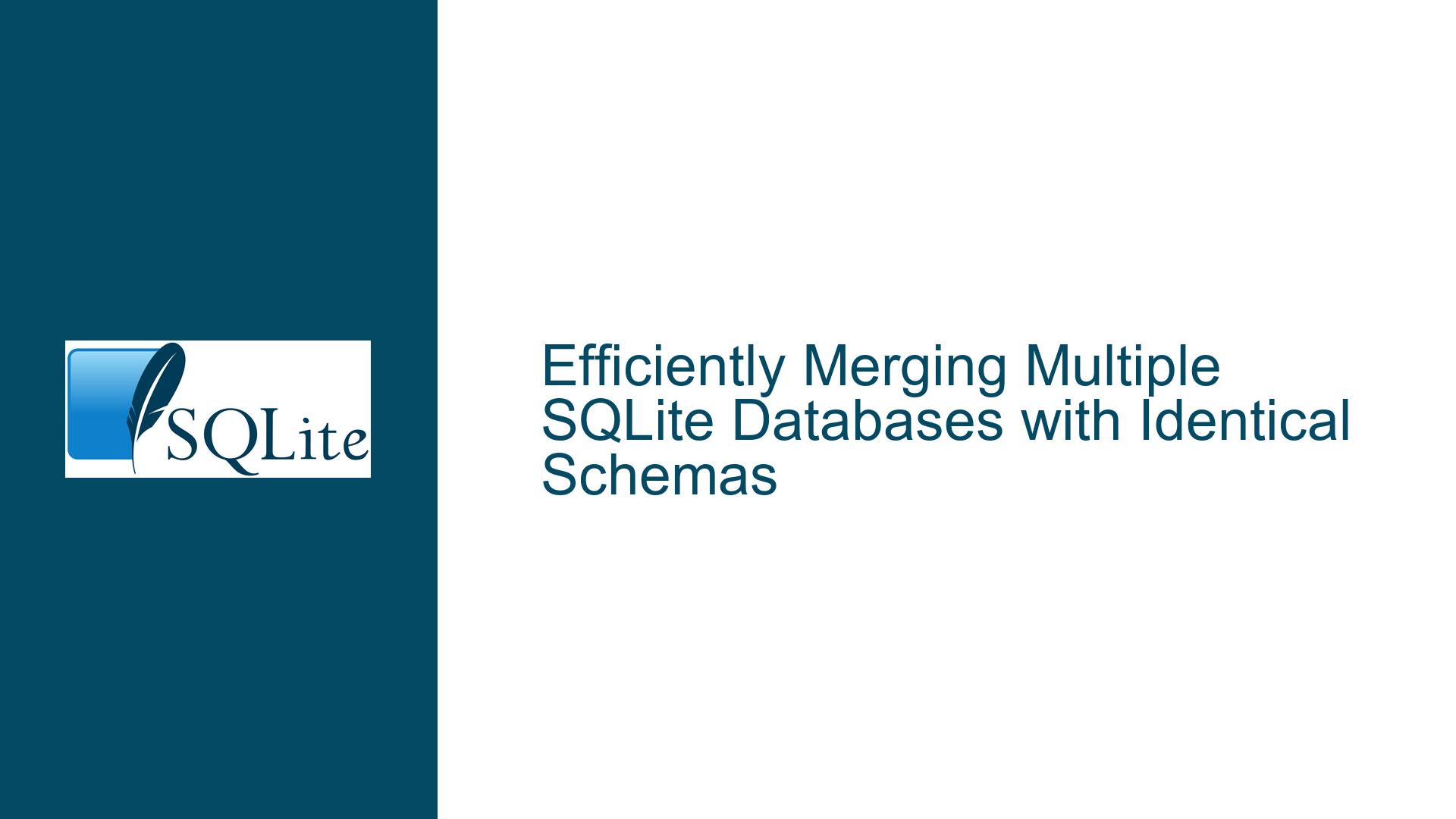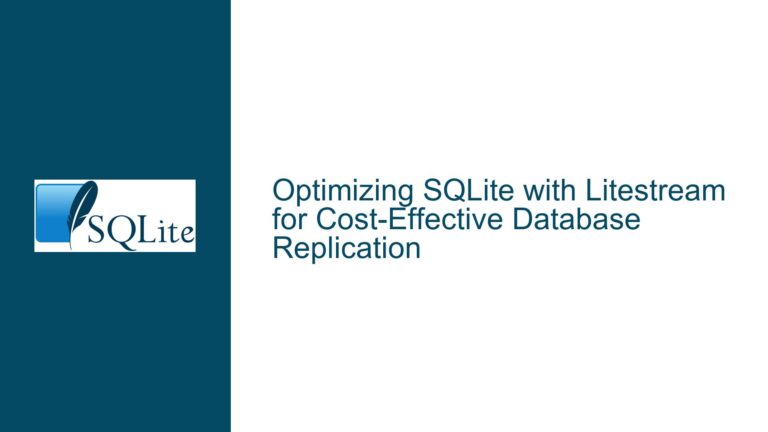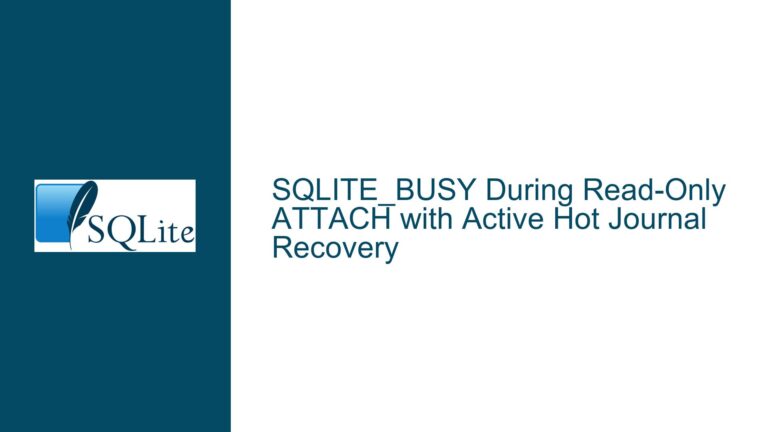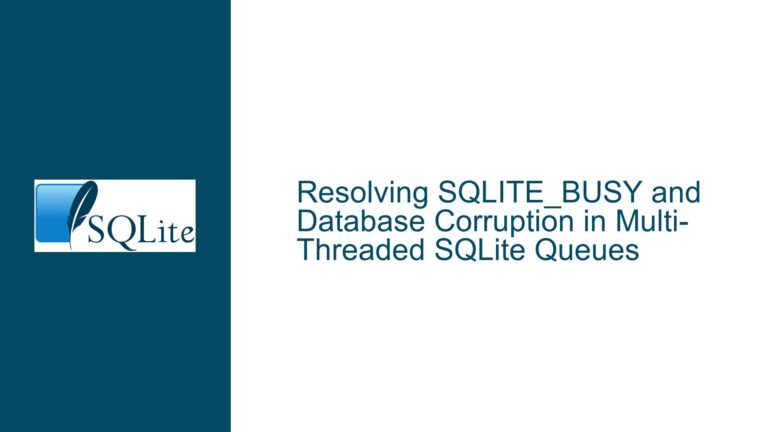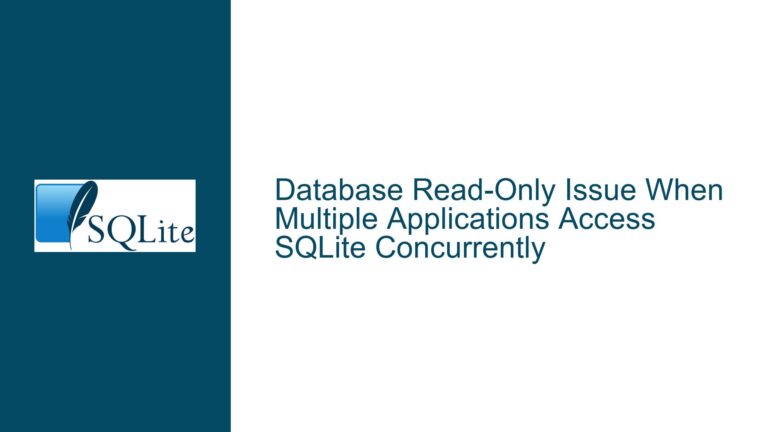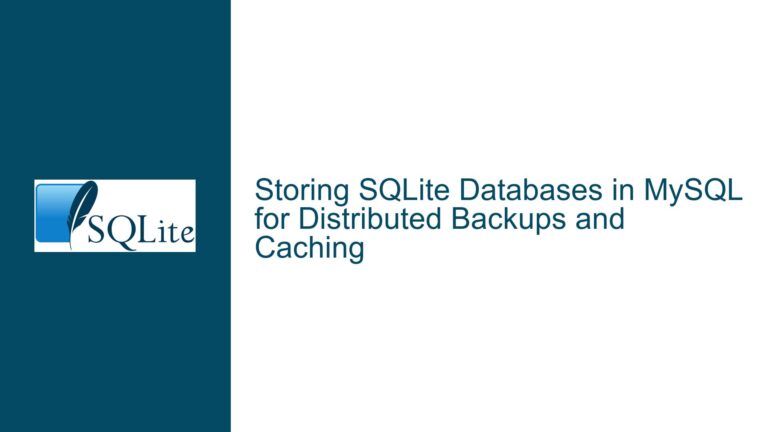Efficiently Merging Multiple SQLite Databases with Identical Schemas
Understanding the Synchronization Challenge in Offline-First Applications
Field technicians working in environments without internet connectivity rely on offline-first applications to collect sensor data, configure devices, and store operational logs. These applications often use SQLite databases due to their portability, self-contained nature, and compatibility with embedded systems. A common requirement in such scenarios is synchronizing data from multiple SQLite database files into a centralized database after technicians return to a networked environment. Each technician’s device generates a separate database file with identical schemas but distinct data rows. The synchronization process must merge these databases into a single master database without introducing duplicates, violating primary key constraints, or corrupting relational integrity.
The brute-force approach—iterating through each row in every table and conditionally inserting missing records—works for small datasets but becomes inefficient as data volume grows. This method requires manually handling primary key conflicts, transaction management, and schema-specific edge cases. Developers often seek optimized techniques to merge SQLite databases directly at the file level or via SQL operations that minimize redundant data transfers. However, SQLite’s internal architecture imposes constraints that make naive merging strategies (e.g., concatenating database files) unfeasible.
Architectural and Operational Constraints Preventing Direct Database Merging
Absolute Page Numbering and B-Tree Root Pages
Every SQLite database file is a self-contained B-tree structure where data pages are referenced by absolute positions. When two databases are merged, their page numbers would overlap, causing catastrophic corruption. For example, the sqlite_master table (which stores schema metadata) in each database references root pages for tables and indexes. Merging two databases without adjusting these root page references would render the combined file unreadable.
Autovacuum and Free-Page Management
Databases configured with autovacuum=INCREMENTAL or autovacuum=FULL manage free pages differently, complicating file-level merges. Autovacuum-enabled databases track unused pages in a linked list, and appending another database would disrupt this list. Even if autovacuum is disabled, the merged file’s size and page allocation would mismatch the original databases’ internal bookkeeping.
Row-Level Merging Logic and Unique Constraints
Merging rows from multiple databases requires resolving primary key conflicts, unique index violations, and foreign key dependencies. For instance, if two technicians independently insert records into a readings table with an INTEGER PRIMARY KEY AUTOINCREMENT column, their databases might assign the same auto-incremented IDs to different records. A naive append operation would trigger UNIQUE constraint errors. Additionally, application-specific logic (e.g., retaining the latest timestamped record) may necessitate custom conflict resolution beyond SQLite’s built-in ON CONFLICT clauses.
Write-Ahead Logging (WAL) and Shared Cache Modes
Databases using WAL mode or shared cache have additional files (e.g., -wal, -shm) that store uncommitted transactions. Attempting to merge databases while these files exist risks importing partial or inconsistent transactions.
Strategies for Reliable and Scalable Database Merging
Schema Harmonization and Foreign Key Handling
Before merging, ensure all databases use identical schema versions. Disable foreign key constraints during the merge to avoid temporary violations:
PRAGMA foreign_keys = OFF;
Re-enable them after merging and validate integrity:
PRAGMA foreign_keys = ON;
PRAGMA foreign_key_check;
Attaching Databases and Selective Data Transfer
Use the ATTACH DATABASE command to mount source databases into the target database’s connection. For each table, insert records from the attached database while handling conflicts:
ATTACH '/path/technician2.db' AS src;
INSERT INTO main.readings
SELECT * FROM src.readings
WHERE id NOT IN (SELECT id FROM main.readings);
DETACH DATABASE src;
For large datasets, batch inserts within transactions improve performance:
BEGIN TRANSACTION;
INSERT INTO main.configurations
SELECT * FROM src.configurations
ON CONFLICT(config_id) DO UPDATE SET
value = excluded.value,
timestamp = excluded.timestamp
WHERE excluded.timestamp > configurations.timestamp;
COMMIT;
Leveraging the SQLite Backup API
The sqlite3_backup API allows efficient copying of database content at the page level, bypassing SQL parsing. This method is faster than ATTACH for entire database transfers but still requires conflict resolution for overlapping records. Example using Python’s sqlite3 module:
import sqlite3
def merge_databases(target_path, source_paths):
target = sqlite3.connect(target_path)
for source_path in source_paths:
source = sqlite3.connect(source_path)
source.backup(target, pages=100, sleep=0.1) # Incremental backup
source.close()
target.close()
Exporting and Reimporting via SQL Dumps
Generate a SQL dump from each source database and replay it against the target database. Use the .dump command in the SQLite CLI:
sqlite3 technician1.db .dump | sqlite3 merged.db
sqlite3 technician2.db .dump | sqlite3 merged.db
This approach handles schema differences if the target database is empty but requires scripting to filter INSERT statements that violate unique constraints.
Custom Conflict Resolution with UPSERT
For tables without auto-incrementing keys, use UPSERT (UPDATE ON CONFLICT) to merge records conditionally. Suppose a sensor_logs table uses a composite primary key of (sensor_id, timestamp):
INSERT INTO main.sensor_logs
SELECT * FROM src.sensor_logs
ON CONFLICT(sensor_id, timestamp) DO UPDATE SET
value = excluded.value
WHERE excluded.value IS NOT NULL;
Resetting Auto-Increment Sequences
After merging, reset sequences for auto-increment columns to prevent future conflicts:
UPDATE sqlite_sequence
SET seq = (SELECT MAX(id) FROM readings)
WHERE name = 'readings';
File-Level Merging with Caution
While unsafe for general use, appending databases as write-ahead log (WAL) files can work in controlled scenarios:
cat technician1.db technician2.db > merged.db
This method requires both databases to be in WAL mode, with no pending transactions, and identical page sizes. Validate the merged file using:
PRAGMA integrity_check;
Performance Optimization Techniques
- Index Management: Drop non-unique indexes before merging and rebuild them afterward.
- Batch Insertions: Use
INSERT INTO ... SELECTwithLIMITandOFFSETto process large tables in chunks. - In-Memory Databases: Stage merges in an in-memory database for faster operations before writing to disk.
Post-Merge Validation
- Check for orphaned foreign key references:
PRAGMA foreign_key_check;
- Rebuild the database to reclaim space and defragment pages:
VACUUM;
- Verify application-specific invariants (e.g., timestamp ordering).
By systematically addressing SQLite’s architectural constraints and employing a combination of SQL operations, backup APIs, and conflict resolution logic, developers can achieve robust and efficient merging of multiple databases in offline-first synchronization scenarios.
